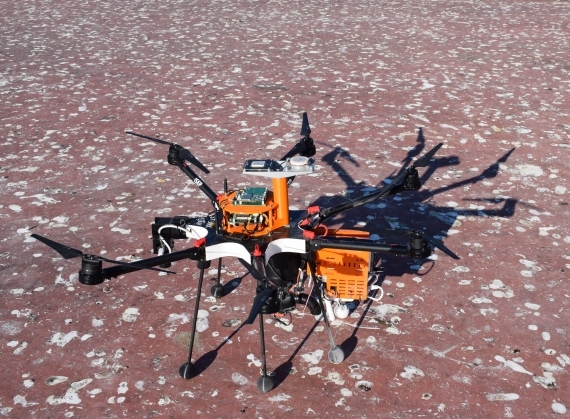Activities
STORK I
Unmanned Aerial Vehicle (UAV)
Description
STORK I is an Unmanned Aerial Vehicle (UAV), which has been developed by INESC TEC and the Autonomous Systems
Laboratory (LSA) of the School of Engineering of the Polytechnic Institute of
Porto (ISEP). It is operating since 2015.
STORK I is a customized hexarotor based on a commercial
airframe from DJI S900. It has a 900 mm diameter, a payload capacity of 4.9 kg
with an endurance up to 25 minutes. It uses an open-source autopilot from
Pixhawk project running PX4 firmware.
In order to communicate and control the vehicle, several
wireless communication links are used, such as:
- A RF link at 433 MHz (low frequency, in order to increase the range), used to remotely operate the vehicle, if needed.
- A RF link at 2.4 GHz, used by the emergency stop system.
- A 5 GHz Wi-Fi link between the on-board computer and the base station, used to send commands and receive information about the vehicle’s status and the collected data.
- A RF link is used to ensure a redundant communication line, which provides information about the vehicle’s status, even when the Wi-Fi link is lost.
Besides the autopilot sensors needed for the navigation purposes – Inertial measurement unit (IMU) and Ublox Neo M8N Global Navigation Satellite System (GNSS) – the sensorial payload comprises a 0.3 MP PointGrey Firefly FMVU-03MTC-CS visible camera pointing forward and a 2.3 MP Pointgrey Grasshoper GS3-U3-23S6C-C pointing down. The on-board computer is an Odroid XU3 running Ubuntu 14.04 with Robot Operating System (ROS) Indigo.
This configuration allows to develop an autonomous aerial vehicle capable of accomplishing real time sensor data acquisition and processing from the surrounding environment.
Specifications
General
- Maximum height: 300 m
- Autonomy (flight time): 25 minutes
- Range: 300 m
- Propulsion: six brushless rotors (900 mm of diameter)
- Horizontal speed: 0-10 m/s
- Vertical speed: 0-6 m/s (ascent and descent)
- Degrees of freedom: throttle, roll, pitch, yaw
- Communications: Wi-Fi (5 GHz), telemetry (433 MHz)
- Navigation system: GPS, FCU (with accelerometer, barometer, gyroscope, magnetometer) and IMU (Inertial Measurement Unit)
- Flight control: ground console, autonomous missions
Operation
- Vehicle type: Unmanned Aerial Vehicle (UAV)
- Body shape (frame): hexa-copter
- Body material: carbon fibre and plastic
- Propellers material: carbon fibre
- Diameter: 50 cm (closed), 90 cm (operation)
- Height: 70 cm
- Arm length: 36 cm
- Weight: 3 kg
- Power: rechargeable batteries (LiPo, 22000 mAh)
- Battery charge time: 2 hours
- Payload capacity: 4.9 kg
- Payload interfaces/ports: USB (2.0 and 3.0)
Sensors
- Video cameras (different viewing angles)
- LIDAR
Photos and videos are
available at the Gallery.
